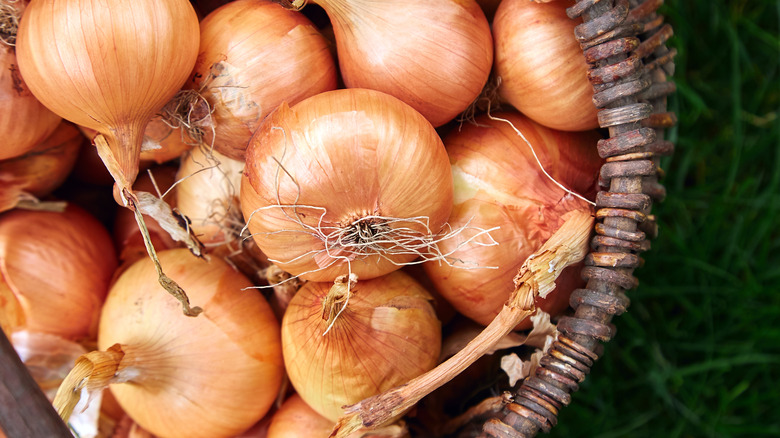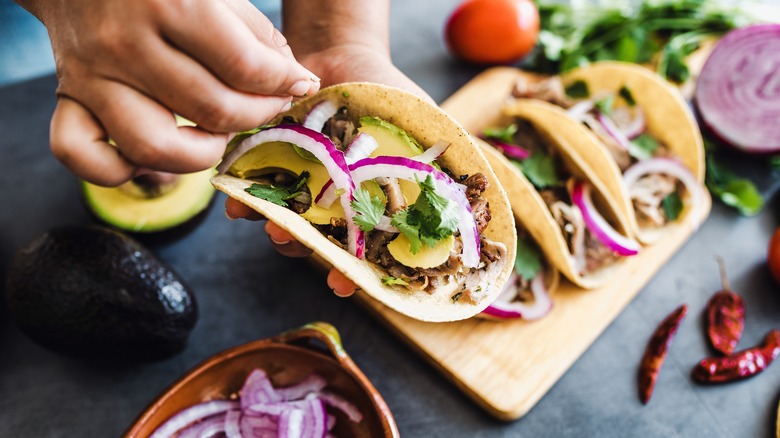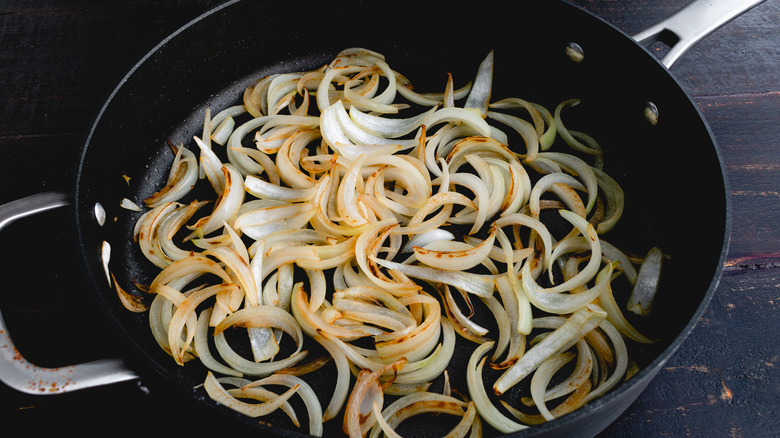Actually, There Is A Difference Between White And Yellow Onions
To famous poet Gertrude Stein, a "...rose is a rose is a rose." The same can not be said for onions, however. There is no shortage of onion varieties to choose from when cooking. Many home cooks have found themselves puzzling over the onion section of the grocery store, wondering which variety would make the snappiest onion ring or most delicious French onion soup. And while, on the surface, most onions seem to be interchangeable, knowing your onions can stop you from getting into some pretty dicey cooking situations.
The two most popular, and easily mistaken, onions are white and yellow onions. Both are large, round, and covered in a papery skin. To a novice, picking one over the other may only seem to be a matter of price or selection. But white and yellow onions are actually very different, and knowing how and when to use both can take your cooking to the next level. If you're looking for versatility in cooking, yellow onions are the way to go, as their structure holds up well in cooking. However, they can taste unpleasant if served raw. In raw foods such as salads and salsas, white onions are the better choice.
The best uses for yellow and white onions
Yellow onions are the most popular variety in America, accounting for a whopping 90% of onions sold. This is thanks to their ability to hold up in cooked dishes. Raw, yellow onions have a sharp, distinct taste. However, their flavor tends to mellow during cooking, and their structure holds up well in dishes such as pot roast, which require long cooking periods. Basically, if you're looking to cook your onions, yellow is the way to go.
While yellow onions are the go-to for cooking tasks such as caramelizing, white onions are perfectly suitable for serving without the task of sautéing or roasting. Because of their lower sulfur content and high sugar content, white onions are sweeter with a sharp flavor profile, contrasting with the pungent taste of raw yellow onions, which have a higher sulfur content. This means that white onions can, and should, be served raw. Their sweet, sharp flavor is the perfect punctuation for a fresh salad. Diced white onions can add a distinct flavor to your homemade pico de gallo, and sliced into rings, they make for the perfect burger topping.
Another onion that is perhaps best kept raw is red onions. Known for their distinctive, purply color, red onions are an almost ubiquitous find in salad bars. They are a bit milder than both yellow and white onions and are sweeter than white onions. Red onions can add color and crunch to your salad, burger, or sandwich. Additionally, red onions are perfect for pickling, maintaining their signature crunch and turning bright pink, adding a pop of color to your salad or charcuterie board.
Hitting the sweet (onion) spot
The rules of yellow versus white onions are not absolute, however. Onions are very layered and complex vegetables, after all. One type of onion might just be able to serve as a middle ground for those still caught between the workhorse yellow onion and the crisp white onions. Sweet onions feature the best of both worlds in terms of flavor and texture. Though sweet onions are technically white onions, they feature a higher sugar content and lower sulfur content than regular white onions, giving them a milder flavor. Varieties of sweet onions include Walla Walla, Maui, and Vidalia onions.
Sweet onions are known for their mild flavor, which makes them perfect for both raw and cooked dishes. In fact, raw sweet onions are often used as a simple and delicious sandwich filling. Sweet onion sandwiches are a staple for many Southern diners. The sandwich is simple, featuring a filling of sweet onions, such as Vidalias, with mayonnaise and a parsley garnish. But if that's too much onion for you, Vidalias make for a great garnish, and because of their high sugar content, they are perfect for caramelizing.
However, this doesn't mean that sweet onions are the end all, be all for your culinary needs. There is a whole world of onion varieties to use in your cooking adventures. Exploring different varieties can help you to find which onion perfectly suits your recipe and your palate.


